Column: The lithium revolution has arrived at California’s Salton Sea
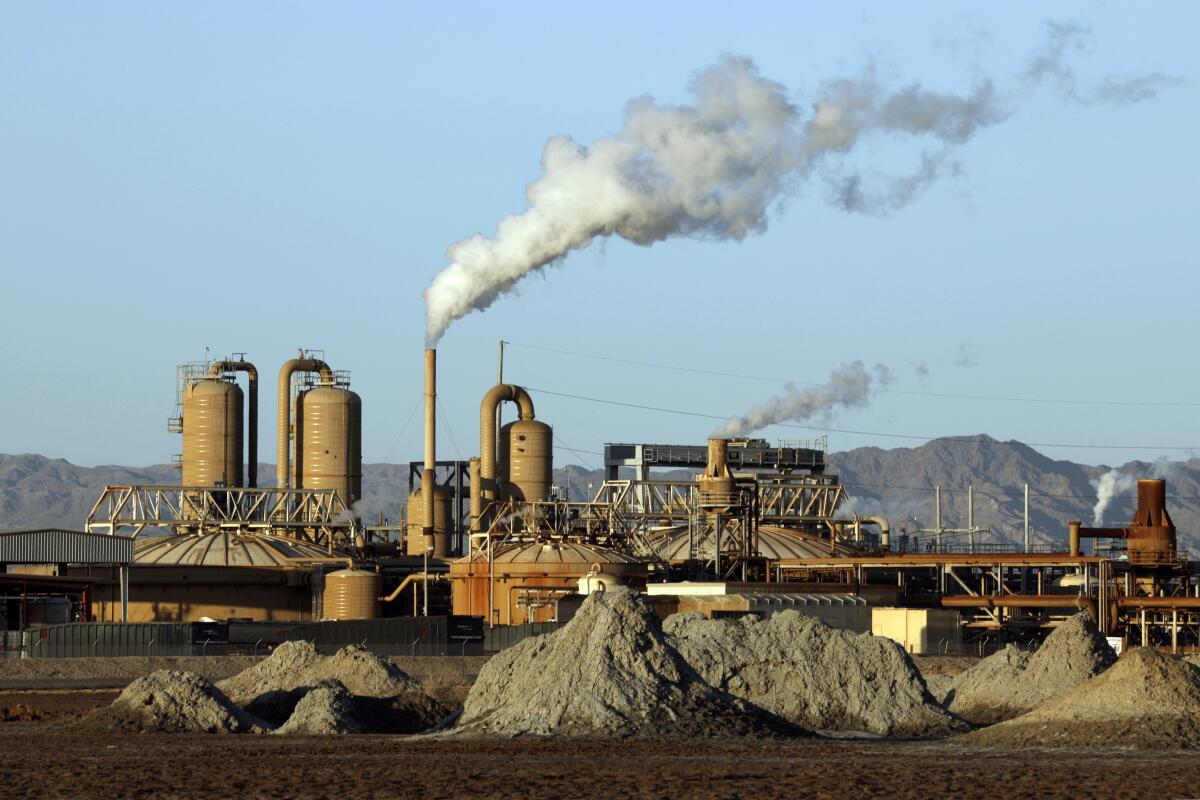
- Share via
I’m finally convinced: California’s Imperial Valley will be a major player in the clean energy transition.
After a dozen years of engineering, permitting and financing, the Australian firm Controlled Thermal Resources is ready to start building a lithium extraction and geothermal power plant at the southern end of the Salton Sea, more than 150 miles southeast of Los Angeles. A groundbreaking ceremony is planned for Friday near the shore of the shrinking desert lake.
John Podesta, who once served as President Clinton’s chief of staff and is now President Biden’s clean energy advisor, will be at the groundbreaking. When I talked with him ahead of the event, he stressed the importance of the U.S. lessening its reliance on China and other countries for critical minerals such as lithium — and the particular benefits for Imperial County, an agricultural mecca that sits along the U.S.-Mexico border and has some of California’s lowest incomes.
“The work is going to be done by union labor. These are going to be good jobs,” Podesta said.
You're reading Boiling Point
Sammy Roth gets you up to speed on climate change, energy and the environment. Sign up to get it in your inbox twice a week.
You may occasionally receive promotional content from the Los Angeles Times.
He’s right — Friday’s groundbreaking is a big deal. For a bunch of reasons.
Unlike solar panels and wind turbines, geothermal plants can generate pollution-free electricity 24 hours a day by tapping into a powerful pocket of underground heat thousands of feet below the Salton Sea. If we want to transition away from planet-warming fossil fuels and power our homes and businesses with 100% climate-friendly energy, geothermal can help.
Lithium, meanwhile, is a key ingredient in the batteries that power electric cars — and also store solar and wind energy for times when the sun isn’t shining and the wind isn’t blowing. And unlike many other lithium mines, Controlled Thermal’s “Hell’s Kitchen” project — and others planned for the Salton Sea region — would do little environmental damage.
But until now, I wasn’t sure whether Hell’s Kitchen would move forward.
Companies have been trying to resolve the economic and technical barriers to Imperial Valley lithium extraction for years. Some of my first stories for the Desert Sun newspaper, nearly a decade ago, were about Simbol Materials, a startup that claimed it had cracked the code. In 2015, I wrote about Simbol’s plans for a lithium plant that would employ 400 construction workers.
Less than a month later, the company fired most of its staff.
So when I first wrote about Controlled Thermal’s plans eight years ago, I was skeptical.
Would the company bring down the high up-front costs that had stymied other developers looking to add to the Imperial Valley’s aging fleet of geothermal power plants? And would Controlled Thermal’s lithium extraction plans be foiled by the highly corrosive, superheated underground fluid in which the valuable metal is dissolved, which can degrade equipment?
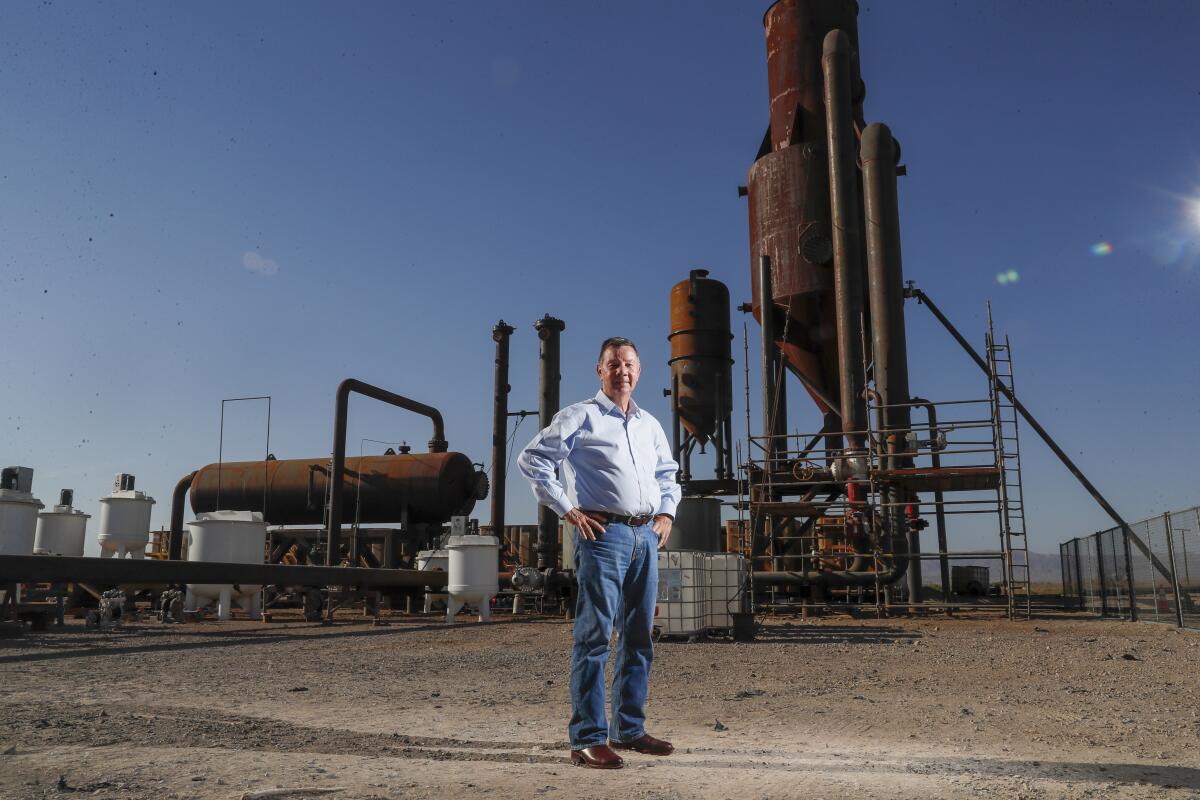
I kept asking those questions when the company started moving dirt around, and when it actually drilled its first wells. I remained skeptical when General Motors invested in Hell’s Kitchen, and when auto giant Stellantis agreed to buy some of the lithium.
Now, though? With a groundbreaking ceremony on the docket for Hell’s Kitchen and one of the president’s top advisors planning to attend, I’m finally feeling confident that the lithium revolution has arrived at the Salton Sea.
“It’s been a journey, as you know,” Controlled Thermal Chief Executive Rod Colwell told me.
Colwell and his collaborators still have big plans in the works. They envision the project that breaks ground Friday as the first of seven phases, with the potential to eventually produce 175,000 metric tons per year of lithium hydroxide and 350 megawatts of round-the-clock geothermal power. Other companies could add to the haul, with federal researchers estimating last year that the superheated brine deep beneath the Salton Sea contains enough lithium to fuel 382 million electric-vehicle batteries.
But for now, Phase One of Hell’s Kitchen is a long-awaited win.
The project will produce about 50 megawatts of geothermal power, with the Imperial Irrigation District, the area’s publicly owned electric utility, buying most of it. The rest of the power will fuel on-site operations, helping Controlled Thermal become one of the first major domestic sources of “white gold.” The facility will churn out 25,000 metric tons of lithium hydroxide annually.
“This is a one-way ticket. It’s official,” Colwell said. “This is full commercial construction.”
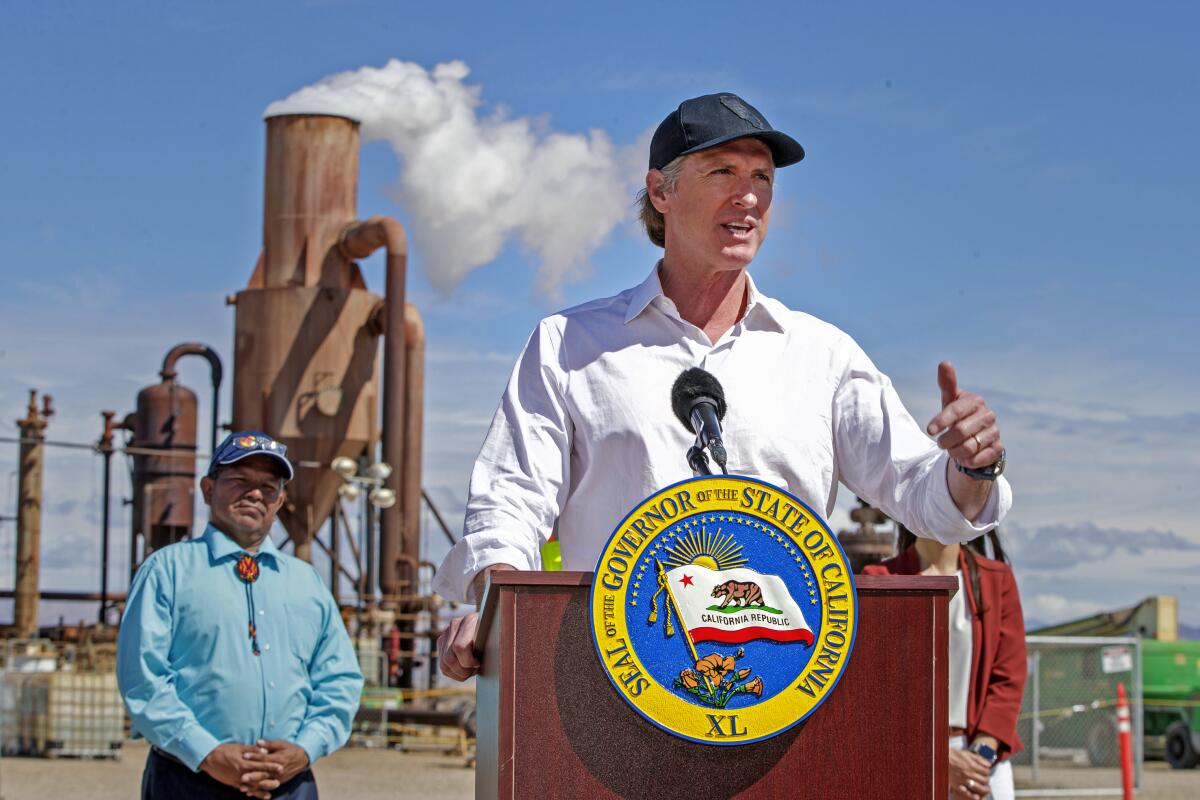
Controlled Thermal expects to employ 480 people during construction and 220 people once Phase One is up and running. The company has a project labor agreement with organized labor, meaning those jobs will be filled by unionized workers.
With those jobs in mind, Chris Hannan — president of the politically influential State Building and Construction Trades Council — also plans to attend the Friday groundbreaking. He told me many of the jobs will go to Imperial County residents, some of whom will learn valuable skills through apprenticeship programs and go on to do similar work by the Salton Sea and elsewhere.
“Controlled Thermal Resources is sending a strong signal about doing it the right way,” Hannan said.
All that said, there’s no such thing as a clean energy project without controversy. And Hell’s Kitchen is no exception.
Before the Imperial County supervisors voted this week to approve the construction permits, they heard from a lawyer for Comite Civico del Valle, an environmental justice group that has raised concerns about potential air and water contamination.
“The Imperial Valley has a proud tradition of growing the food that feeds America and contributing to the economic growth of the Golden State,” Luis Olmedo, the group’s executive director, wrote last month. “But that tradition has already come at a cost to the local health and natural environment. People and residents should continue to stay engaged and work to ensure that [Controlled Thermal’s] Hell’s Kitchen projects offer the highest standards for the health and safety of our community.”
Podesta has helped the company work through some of the roadblocks. Biden’s clean energy advisor coordinated with the Army Corps of Engineers to speed up permitting for a wetland that Controlled Thermal will build near its plant, to help make up for the inevitable environmental consequences — such as traffic and dust — that are inherent to any industrial facility.
“We want to see these projects built. But we also want to make sure they’re done with environmental integrity,” Podesta said.
All that said, the environmental issues arising from lithium and geothermal energy production at the Salton Sea are far less serious than other renewable energy projects I’ve covered. Solar farms can sprawl across thousands of acres of pristine wildlife habitat; wind turbines can kill birds, although not nearly as many as some critics would have you believe.
Phase One of Hell’s Kitchen will cover just 68 acres. And the surrounding lands are already dotted with geothermal power plants, sprouting up across a vast desert expense bordered by nearly half a million acres of green farm fields to the south and the rapidly receding shoreline of the Salton Sea — an environmental and public health crisis decades in the making — to the north.
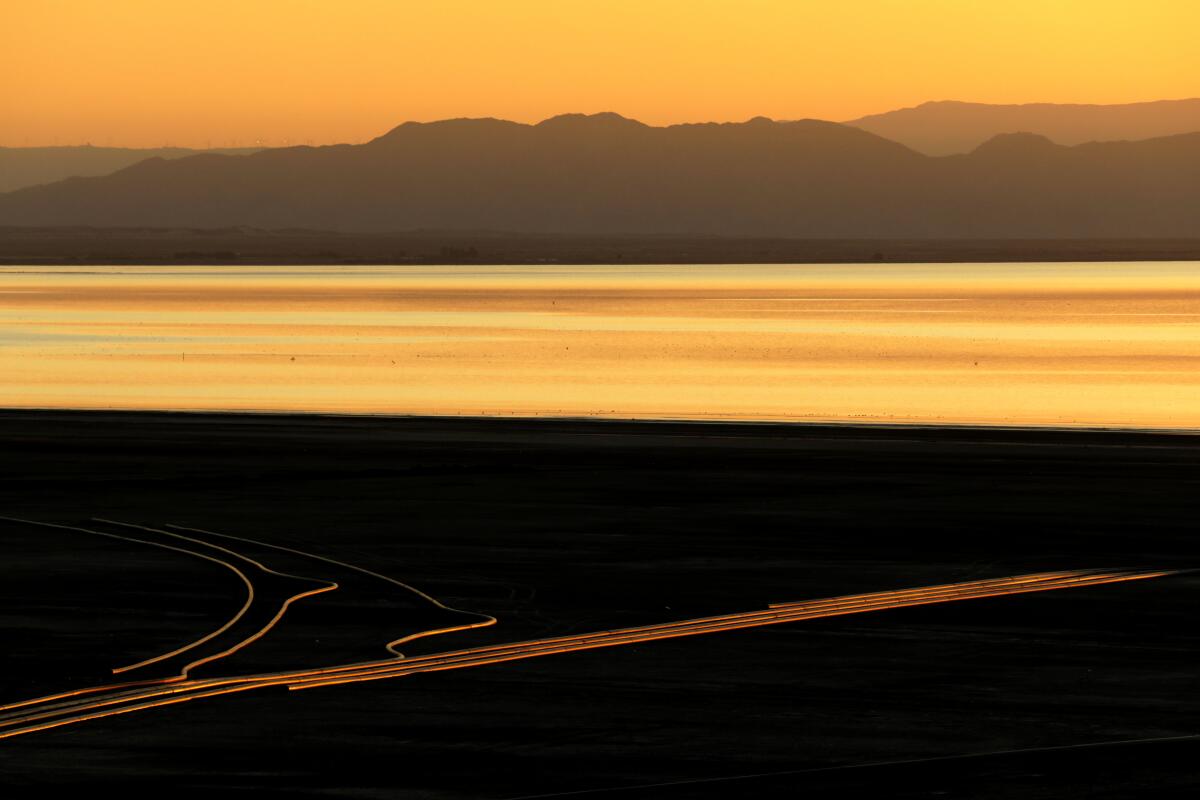
The clean energy revolution won’t solve all of the Imperial Valley’s problems, no matter how many jobs or how much tax revenue it generates. The Salton Sea will keep shrinking as global warming saps the Colorado River’s flows, leading to less water irrigating Imperial Valley farm fields and running off into the desert lake. Toxic dust particles will keep getting blown off the ever-drier lakebed and into the air breathed by the region’s low-income, largely Latino communities.
But lithium and geothermal will help, at least a little bit. The more jobs, the more tax revenue, the better.
There’s a similar dynamic at play with America’s climate goals.
The Salton Sea geothermal hot spot alone won’t get us to 100% clean energy by 2035, the target set by Biden. Nor will the underground lithium storehouse be enough to avert the need for other, more environmentally harmful lithium mines.
When I asked Podesta about one of those mines — Thacker Pass, which began construction on public lands in Nevada last year despite the best efforts of Native American tribes who said it would infringe on a sacred site — he defended Biden’s track record on Indigenous affairs, saying no president has had “a stronger commitment to both our trust and treaty obligations.”
Moving forward on much-needed clean energy projects, Podesta added, would require close consultation with tribes.
“We can work these things out if people get together, particularly if there’s early consultation and the community voices are listened to,” he said. “You can find paths forward. And I think that is true and will be true at Thacker Pass.”
A major power line that started construction last year in New Mexico offers another example of the tension.
As I’ve written previously, the 550-mile SunZia electric line would help bring wind energy from New Mexico to California. But the project faces opposition in Arizona’s San Pedro River Valley. Several tribes and conservation groups sued the federal government last week to try to block construction, saying SunZia would disturb sacred areas and sensitive ecosystems.
Podesta, as it happens, was at SunZia’s groundbreaking too. He said the federal Bureau of Land Management looked closely at the potential environmental harms and “decided that the conflicts were not such that they should stop” construction.
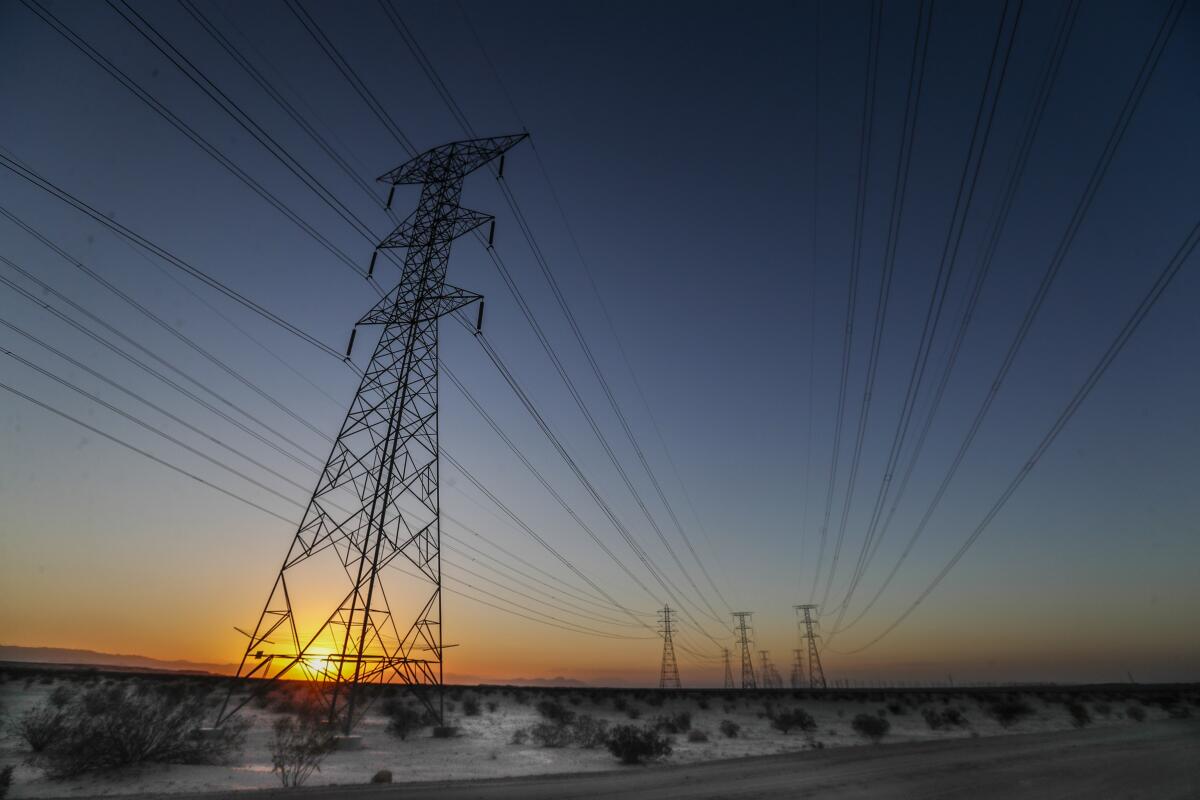
To Podesta, the power line is first and foremost a reminder that we need to approve renewable energy projects more quickly — even when those projects are controversial. SunZia spent an astonishing 17 years going through federal permitting.
“I worked on that in the Obama administration,” Podesta said.
So here’s hoping construction moves forward without delay at Hell’s Kitchen, and at other companies’ project sites by the Salton Sea. To the extent these relatively low-controversy projects help us avoid thornier conflicts over solar farms, wind turbines or traditional lithium mines, we’ll all be better off. Same goes for rooftop solar panels, by the way. The faster, the better.
But to prevent the wildfires, heat waves, droughts and floods of the climate crisis from getting deadlier and more destructive than they already are, we need to stop burning coal, oil and natural gas as quickly as possible. And scientists have found there’s no way to do that without a lot of large-scale energy projects — many of which will have environmental side effects.
So yes, three cheers for Salton Sea lithium and geothermal. Just know that it’s the beginning, not the end.
ONE MORE THING
As I was writing this column on Wednesday, USC’s Annenberg School for Communication and Journalism dropped Season 1 of Electric Futures, a new podcast series focused on lesser-known aspects of the energy transition — and as it happens, Season 1 focuses on lithium extraction in the Imperial Valley. Small world!
I’m looking forward to the podcast, and not just because they interviewed me. Listen on Amazon, Apple Podcasts or Spotify.
ACTUALLY, JUST ONE MORE
One of the 115 Los Angeles Times staff members who received layoff notices earlier this week was Laura Blasey, an editor for the last four years on our newsletters desk. Laura has been an invaluable partner in publishing this newsletter, brainstorming subject lines and headlines, dealing with technical snafus and helping craft strategy to reach more readers.
If you’re an editor looking to grow your newsletter operation or otherwise build audience, Laura would be a fantastic hire.
This column is the latest edition of Boiling Point, an email newsletter about climate change and the environment in California and the American West. You can sign up for Boiling Point here. And for more climate and environment news, follow @Sammy_Roth on X.
Toward a more sustainable California
Get Boiling Point, our newsletter exploring climate change, energy and the environment, and become part of the conversation — and the solution.
You may occasionally receive promotional content from the Los Angeles Times.




